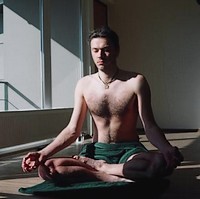There are various spellings for this mudra: asvini, ashvini, ashwini… It seems that the most common is the latter one. The meaning of ashwini mudra is a horse gesture or sign. It is not asana in the full sense, though the mudra is usually performed in padmasana or the lotus pose. Also it can be done in viparita karani, when practiced within the framework of kriya yoga.
Ashwini Mudra Practice
In essence, the practice is a rhythmic contraction of anal sphincter. Although it sounds simple, nevertheless it is an important part of many advanced yoga practices; also ashwini mudra can serve as a mudra for beginners before one can proceed to mula bandha, maha mudra or similar.
What it does?
 It is a kind of upstream prana regulator. It is a common practice for many oriental systems, like Qigong or Taoist yoga. But whichever practice you take, the purpose of the mudra is usually the same: to pump prana into internal organs to prepare them for higher techniques or practices. Also ashwini mudra can make your organs healthy, and more resistant to unfavorable conditions and damages.
It is a kind of upstream prana regulator. It is a common practice for many oriental systems, like Qigong or Taoist yoga. But whichever practice you take, the purpose of the mudra is usually the same: to pump prana into internal organs to prepare them for higher techniques or practices. Also ashwini mudra can make your organs healthy, and more resistant to unfavorable conditions and damages.
Ashwini Mudra: How to Do It
 Ashwini mudra is a part of mula bandha and it forces prana to come upward the spine because of sequential contraction and relaxation of anal sphincter. With each push (contraction) prana raises to a certain level. The process is somewhat different for men and women due to the difference in their physiology.
Ashwini mudra is a part of mula bandha and it forces prana to come upward the spine because of sequential contraction and relaxation of anal sphincter. With each push (contraction) prana raises to a certain level. The process is somewhat different for men and women due to the difference in their physiology.
In order to bring the flow of prana to the top of the head, women need to complete 5 contractions of anal muscles; men should do 4 contractions. Once you get experienced enough, you can do it with a single contraction, it does not matter man or woman you are.
So for women it is recommended to do 5 contractions – this would be one cycle – and for men – 4 contractions.
How to judge you did it right? The feeling of upstream flow of prana is the sign; you will feel that shivers run from the bottom of the spine and along it to the top of your head. So, you inhale, hold your breath, do the required number of contractions, then you relax the anal muscles, but do not release the ashwini mudra yet after you done the last contraction; keep it for a little while instead, then exhale, and while releasing the mudra try to feel how prana after reaching the top of your head, goes down through your muscles, bones and organs, and as it gathers in the areas a little below the navel.
If you cannot feel the stream of prana clearly, do nabhi mudra (touching the palate with the tip of your tongue). You can also do some forward circle movements with your shoulders to increase the feeling of the prana flow. Repeat the whole process several times.
Ashwini Mudra Asana
Any asana or yoga pose where the spine is upright and the body is free from stresses, is good for ashwini mudra practice.
Ashwini Mudra Benefits
In addition to the above-described psycho-energetic action, Ashwini Mudra is very effective as a therapeutic agent for diseases of the rectum, hemorrhoids, etc. In conjunction with other exercises or yoga asanas Ashwini-mudra helps eliminate urogenital diseases, as well as many general disorders.

Thank you for Ashwini Mudra suggestions. Let me pratice and get results. Thanks again.
Hi, Sivanu,
Yes, try it – it’s really worth it.
wonderful info but I couldnt get meaning “but do not release the ashwini mudra yet after you done the last contraction”…
what it means? is it asan or the tounge position?
pl guide
Hello, Hema,
It means, that once you do the last contraction, start exhaling BEFORE you start releasing that last contraction. Hope it helps.
Hello,
I sometimes feel that in doing mulbandh, it increases the heat in the body thereby leading to constipation. I have noticed that whenever I do mulbandh I have constipation, so will doing the ashwini mudra increase the constipation?
Thank you
Hello, Alpana,
Usually Ashwini mudra helps with constipation, so you can try it. But don’t overdo it, since too much tension in your intestines may also cause the difficulties in bowel movement.